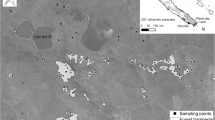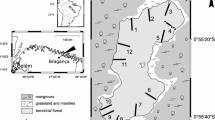Abstract
Coastal barrens support rare plant species but may be threatened by forest encroachment. We determined whether trees spread into coastal barren habitat from forest patches and assessed plant species composition and soil properties across the forest–barren ecotone. We quantified tree age and height, soil properties, and vascular plant, bryophyte and lichen species composition along transects perpendicular to the edges of tree patches within the forest–barren ecotone in coastal Nova Scotia. Randomization tests assessed whether the vegetation and environmental characteristics were significantly different in the transition zone compared to one or both adjoining ecosystems. We used ordination to examine trends in species composition across the ecotone and the relationship to environmental variables. Tree age and height decreased continuously from the forest towards the edge of the forest patches. There were also trends in vegetation composition and structure from the forest into the open barrens. Many species were most abundant within the transition zone, although not always significantly. Soil properties were relatively uniform across the ecotone. The structure and vegetation of the forest–barren ecotone suggests that forest patches act as nuclei for forest expansion on barrens with a typical successional pathway where coastal barren vegetation is gradually replaced by forest species. This encroachment may pose a threat to rare barrens communities. While landscape factors such as salt spray and wind exposure may determine the general locations where forest can establish, biotic processes of growth and dispersal appear to govern the fine-scale expansion of tree patches.




Similar content being viewed by others
References
` ER, Thompson JE, Riley SA et al (1996) Pocono till barrens: shrub savannah persisting on soils favoring forests. Bull Torrey Bot Club 123:330–349
Andrés C, Ojeda F (2002) Effects of afforestation with pines on woody plant diversity of Mediterranean heathlands in southern Spain. Biodivers Conserv 11:1511–1520
Atlantic Canada Conservation Data Center (ACCDC) (2005a) Provincial lists and ranks. http://www.accdc.com/products/lists/. Accessed 13 Oct 2008
Atlantic Canada Conservation Data Center (ACCDC) (2005b) Glossary. http://www.accdc.com/glossary/index.php#rank. Accessed 13 Oct 2008
Baird C (1999) Environmental chemistry. W. H. Freeman and Company, New York
Bazzaz FA (1979) The physiological ecology of plant succession. Annu Rev Ecol Syst 10:351–371
Bradley RL, Titus BD, Fyles JW (1997) Nitrogen acquisition and competitive ability of Kalmia angustifolia L., Paper Birch (Betula papyrifera Marsh.) and Black Spruce (Picea mariana (Mill.) B.S.P.) seedlings grown on different humus forms. Plant Soil 195:209–220
Breshears DD (2006) The grassland–forest continuum: trends in ecosystem properties for woody plant mosaics? Front Ecol Environ 4:96–104
Brodo E, Sharnoff SD, Sharnoff S (2001) Lichens of North America. Yale University Press, New Haven
Brooker RW, Osler GHR, Gollisch J (2008) Association of vegetation and soil mite assemblages with isolated Scots pine trees on a Scottish wet heath. Landsc Ecol 23:861–871
Burley ST (2009) Forest expansion into coastal barrens in Nova Scotia, Canada. M.Sc. thesis, Saint Mary’s University, Canada
Council Officers and Executive Committee (COEC) (1992) Handbook on reference material for soil analysis. Soil and Plant Analysis Council, Inc., Georgia, USA
Crum H (1983) Mosses of the great lakes forest, 3rd edn. University of Michigan, Ann Arbor
Duarte LS, Machado RE, Hartz SM, Pillar V (2006) What saplings can tell us about forest expansion over natural grasslands. J Veg Sci 17:799–808
Dunwiddie PW, Zaremba RE, Harper K (1996) A classification of coastal heathlands and sandplain grasslands in Massachusetts. Rhodora 98:117–145
Ehrenfeld JG, Zhu W, Parsons WFJ (1995) Above- and below-ground characteristics of persistent forest openings in the New Jersey Pinelands. Bull Torrey Bot Club 122:298–305
Faison EK, Foster DR, Oswald WW et al (2006) Early holocene openlands in southern New England. Ecology 87:2537–2547
Fraver S (1994) Vegetation responses along edge-to-interior gradients in the mixed hardwood forests of the Roanoke River basin, North Carolina. Conserv Biol 8:822–832
Harper KA, Macdonald SE (2001) Structure and composition of riparian boreal forest: new methods for analyzing edge influence. Ecology 82:649–659
Harper KA, Macdonald SE (2002) The critical values program for assessing edge influence. Bull Ecol Soc Am 83:61–62
Harris LD (1988) Edge effects and conservation of biotic diversity. Conserv Biol 2:330–332
Hennenberg KJ, Goetze D, Minden V et al (2005) Size-class distribution of Anogeissus leiocarpus (Combretaceae) along forest-savanna ecotones in Northern Ivory Coast. J Trop Ecol 21:273–281
Latham ER, Thompson JE, Riley SA et al (1996) Pocono till barrens: shrub savannah persisting on soils favoring forests. Bull Torrey Bot Club 123:330–349
Latham ER (2003) Shrubland longevity and rare plant species in the Northeastern United States. For Ecol Manage 185:21–39
Linneman JS, Palmer MW (2006) The effect of Juniperus virginiana on plant species composition in an Oklahoma grassland. Commun Ecol 7:235–244
Lloyd KM, McQueen AAM, Lee BJ et al (2000) Evidence on ecotone concepts from switch, environmental and anthropogenic ecotones. J Veg Sci 11:903–910
Mallik AU (1995) Conversion of temperate forests into heaths: role of ecosystem disturbance and ericaceous plants. Environ Manage 19:675–684
Mallik AU (2003) Conifer regeneration problems in boreal and temperate forests with ericaceous understory. Crit Rev Plant Sci 22:341–366
Manning AD, Fischer J, Lindenmayer DB (2006) Scattered trees are keystone structures—implications for conservation. Biol Conserv 132:311–321
Mascarúa LE, Harper KA, Drapeau P (2006) Edge influence on forest structure in large forest remnants, cutblock separators, and riparian buffers in managed black spruce forests. Ecoscience 13:226–233
Maurice KR, Welch JM, Brown CP et al (2004) Pocono mesic till barrens in retreat: topography, fire and forest contagion effects. Landsc Ecol 19:603–620
McKinley DC, Blair JM (2008) Woody plant encroachment by Juniperus virginiana in a mesic native grassland promotes rapid carbon and nitrogen accrual. Ecosystems 11:454–468
Meades WJ (1983) The origin and successional status of anthropogenic dwarf shrub heath in Newfoundland. Adv Space Res 2:97–101
Neily P, McCurdy D, Stuart B et al (2004) Coastal forest communities of the Nova Scotian eastern shore ecodistrict. Nova Scotia Department of Natural Resources
Nova Scotia Museum of Natural History (1997) Natural history of Nova Scotia volume I: topics and habitats. Nova Scotia Museum of Natural History, Nova Scotia
Oberndorfer EC, Lundholm JT (2009) Species richness, abundance, rarity and environmental gradients in coastal barren vegetation. Biodivers Conserv 18:1523–1553
Price JN, Morgan JW (2008) Woody plant encroachment reduces species richness of herb-rich woodlands in southern Australia. Austral Ecol 33:278–289
Rhoades CC, Miller SP, Skinner DL (2005) Forest vegetation and soil patterns across glade-forest ecotones in the Knobs region of Northeastern Kentucky, USA. Am Midl Nat 54:1–10
Roland AE, Smith EC (1963) The flora of Nova Scotia. Nova Scotian Institute of Science, Halifax, Nova Scotia
Saldarriaga JG, West DC, Tharp ML et al (1988) Long-term chronosequence of forest succession in the Upper Rio Negro of Columbia and Venezuela. J Ecol 76:938–958
Shachak M, Boeken B, Groner E et al (2008) Woody species as landscape modulators and their effect on biodiversity patterns. Bioscience 58:209–221
Stark KE, Lundholm JT, Larson DW (2003) Relationships between seed banks and spatial heterogeneity of North American alvar vegetation. J Veg Sci 14:205–212
Stark KE, Lundholm JT, Larson DW (2004) Arrested development of soil on alvars of Ontario, Canada: implications for conservation and restoration. Nat Area J 24:95–100
Verhoeven KJF, Simonsen KL, McIntyre LM (2005) Implementing false discovery rate control: increasing your power. Oikos 108:643–647
Acknowledgements
Tyler Smith provided invaluable help with the statistical components. We thank Kat Dillon, Crystal Hillier, Molly Simons, Sarah Robinson and Jenn Lau for assistance with field work. Sean Basquill and Philip Giles provided critical comments on an earlier version of the paper. Financial support for this project is from NSERC (CGS to S. Burley, Discovery Grant to J. Lundholm) and Saint Mary’s University.
Author information
Authors and Affiliations
Corresponding author
Appendix
Appendix
Rights and permissions
About this article
Cite this article
Burley, S.T., Harper, K.A. & Lundholm, J.T. Vegetation composition, structure and soil properties across coastal forest–barren ecotones. Plant Ecol 211, 279–296 (2010). https://doi.org/10.1007/s11258-010-9789-7
Received:
Accepted:
Published:
Issue Date:
DOI: https://doi.org/10.1007/s11258-010-9789-7




